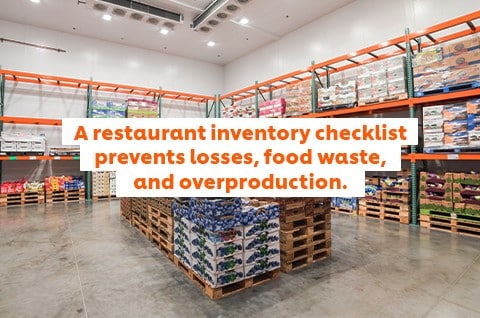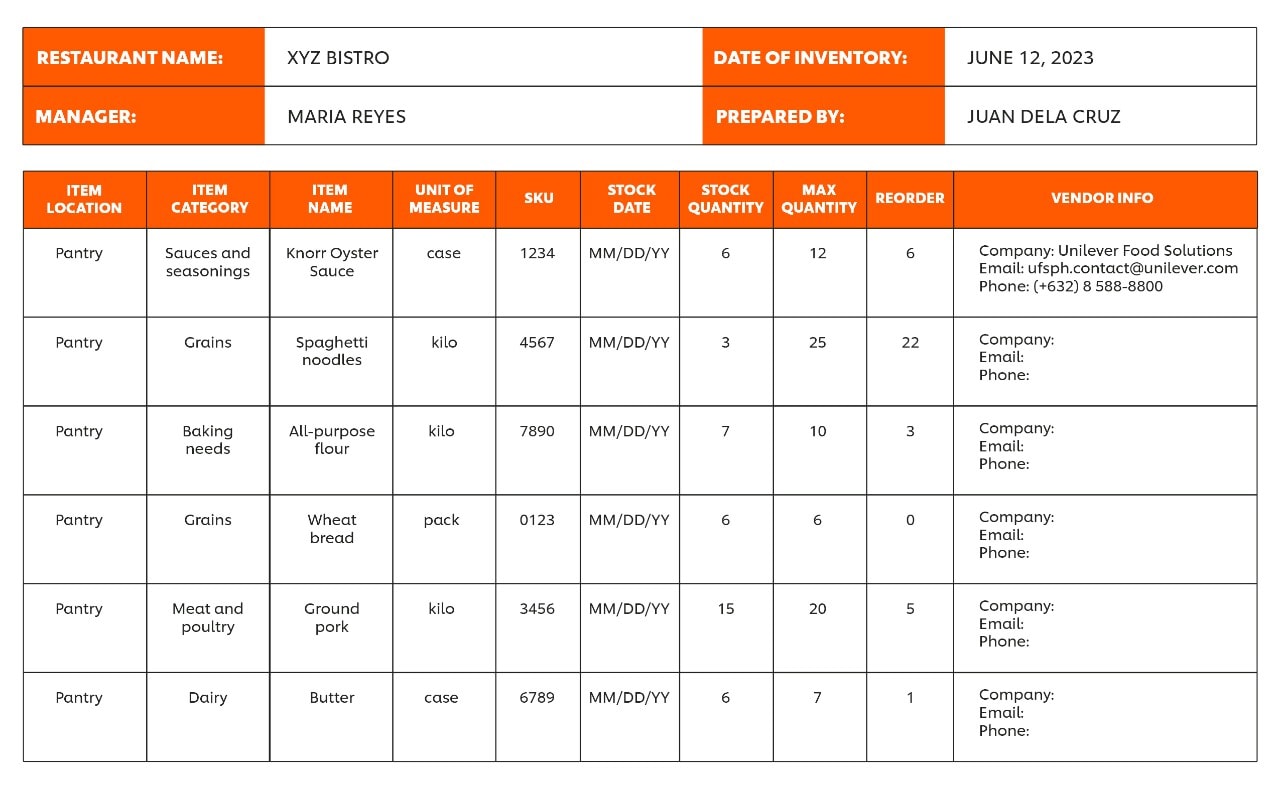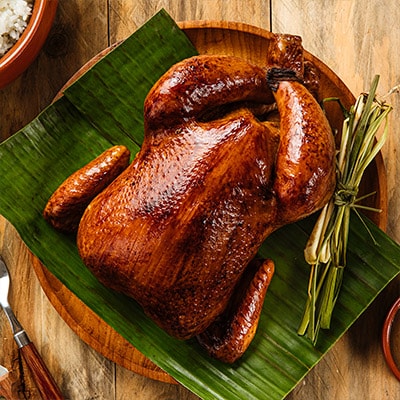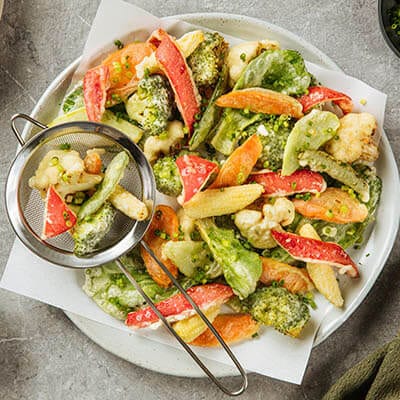Keeping tabs on supplies is critical to your restaurant’s success. After all, it can help you plan a stellar menu and ensure your bestsellers are always available. One of the foolproof ways to streamline tracking is through a restaurant inventory management sheet. This guide teaches you the basics of creating a custom checklist so you never run out of essential goods.
What Is Inventory Management?
Food inventory management is a way of auditing your restaurant stocks. The goal is to determine what types of products and how much your establishment has at any given time. Businesses, especially MSMEs, can utilize inventory printouts for this process. Meanwhile, larger ventures and restaurants with multiple branches can opt for a digital or automated system that uses software on computers or tablets.
Main Benefits of Inventory Management for Restaurants

Loss prevention
Tracking usage and overall inventory size are essential for understanding where food supply investment goes. Equipped with the info, restaurants can improve the cost of production while maximizing profits. Understanding how your purchased inventory relates to restaurant sales helps pinpoint inventory shortages caused by:
- Spills
- Comping disgruntled customers
- Employee mistakes
- Theft
Food waste management
Implementing a stock control system also helps manage labor costs and address the most substantial expense – supply replenishment. An efficient system can minimize waste in your business operations. Here are the most common sources of wastage to look out for:
- Diners over-ordering
- Spoilage
- Overproduction of food items
- Poor portion control
- Various misfires (misread order tickets, returned orders, etc.)
Elements of a Restaurant Management Checklist

The secret to creating an accurate and effective control list is incorporating the correct elements. Make sure you have the following information on your sheet:
1. Item name
Every inventory sheet should include specific item names, especially if the restaurant uses product variations. For example, simply indicating “Hellmann’s Dressing” can lead to overstocking the incorrect variant. Mistakenly reordering numerous cases of Hellmann’s Smoked Chili Dressing risks wastage and profit loss. At the same time, the ingredient you really need, Hellmann’s Charred Tomato and Capers Dressing, for the restaurant’s best-selling poke bowl runs low. Being detail-oriented when compiling your list prevents this mishap.
2. Product category
As your business expands, the number of items in your stock increases, making it more challenging to keep track of them. Inventory checklists allow you to classify supplies into multiple categories. These groupings enable you to organize your stock efficiently and easily access them, leading to more seamless inventory management. Several key classifications you can use are dairy, canned goods, vegetables, grains, sauces, and seasonings.
3. Inventory ID
Does your menu contain a selection of dishes using the same primary ingredient? For example, does your restaurant procure different beef cuts to use in an assortment of recipes? Maybe your meatballs in Knorr Oyster Sauce utilize beef short ribs, sizzling sinigang has shanks, while the salpicao uses tenderloin.
In such cases, having a variety of meats can cause inconsistencies during supply inspection. The solution? Add inventory IDs to each type to avoid confusion and keep data clean. For this, consider using customizable identification numbers, a.k.a. stock-keeping units (SKU). Either manually assign unique numerical values (i.e., 123, 456, or 789) to every product or turn to online SKU generators to speed up the process.
4. Unit of measure
Different items, different measurements. You don’t measure bread the same way you would mayonnaise. So, you’ll want to indicate the unit of measure, such as kilos, grams, or cases, in your checklist for accurate inventory management.
5. Stock quantity
Stock quantity refers to how many units of a particular item you have at present. Accurately tallying your available perishable and shelf-stable goods helps management order the right products at the right time. Identify units and quantities as such:
-
ITEM NAME UNIT STOCK QUANTITY Lady’s Choice Real Mayonnaise tub 1 Beef brisket kg 15
6. Date
Stating the date when staff adds items to the stock enables compliance with the first in, first out (FIFO) approach. This practice guarantees that the kitchen uses ingredients before their best-by date and maintains the excellent quality of your dishes.
7. Max quantity
The maximum quantity represents the upper limit of stocks an establishment can store. For example, if you only have space for five packs of Knorr Cream of Mushroom Soup Mix, you cannot exceed this quantity when reordering. Failure to identify this value can result in excessive stocks and expired goods – in other words, a lot of waste.
8. Reorder total
A reorder total is a specific number of stocks your restaurant needs to replenish. The formula for determining the reorder total is max quantity – stock quantity = reorder quantity.
-
ITEM NAME UNIT STOCK QUANTITY MAX QUANTITY REORDER Knorr Cream of Mushroom Soup Mix kg 2 5 3
9. Item location
Quickly find where certain goods are stored by adding a column specifying their location in your back of house (BOH). Fresh produce goes in the fridge, while canned products and ready-to-use sauces are on stockroom shelves. In contrast, walk-in freezers are the optimal storage solution for frozen meat, poultry, and seafood.
10. Vendor information
Including info on vendors, like their contact number, email, and point person, is optional but beneficial. Gathering this data in one file makes reordering out-of-stock goods more efficient.
Sample Inventory Checklist for Food Businesses
Here’s a sample of a restaurant inventory management checklist you can utilize no matter the size of your food business. Feel free to customize it depending on your needs and goals. You don’t need special inventory software for this; you can input the elements into a spreadsheet and share access with key personnel.

Inventory Management Best Practices
The efficacy of your restaurant's inventory management relies on more than just your checklist. To get optimal results, partner your spreadsheet with these best practices.
1. Keep the stockroom clean and organized.
A disorganized stockroom makes it harder to locate and retrieve items promptly. It also increases the chance of errors and discrepancies while hindering workflow efficiency. To keep your storage in good shape, here are some good habits to exercise:
- Keep your storage space and walk-in freezer clean and orderly.
- Refrain from overcrowding or piling goods on the floor.
- Group items by category. Organize meat with meat and dairy with dairy.
- Label your shelves and containers clearly to avoid ingredient confusion, especially during busy service.
- Include the SKU in your label.
2. Assemble a team and create a schedule.
Keep your inventory up to date by assembling a team to oversee it. Ensure employee productivity by assigning the same people to check supplies and receive new shipments. Next, determine how often staff should conduct an inventory of raw materials. Generally, many food enterprises run nightly checks for fresh goods and weekly for the rest of the products.
3. Use an inventory sheet template.
Improve inventory-taking by using printed templates instead of writing everything manually. You can create a template tailored to your restaurant or download pre-made forms online.
Optimizing your menu with unique dishes can yield increased profits. But poor restaurant inventory management can do the opposite. Even with top-notch recipes and excellent service, your business can lose money on overstocked and expired goods. The simple solution? Implement a strict inventory system to track the turnover of supplies. Use this guide to craft an auditing list and watch your savings grow.



